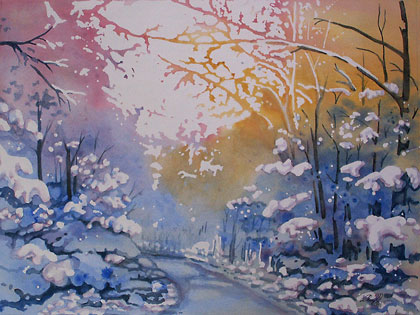Important Notes About Pigments
I have listed the actual pigment used for each colour; that is the specific letters and numbers after the name. No matter what brand of paint you buy, you should be able to find the pigment listed on it and with very few exceptions know that you have the correct colour, even if the name is different. Each company chooses the name of their colours, so for example Red PV 19 may be called Red Rose Deep in one brand and Permanent Rose in another. Learn to look for the specific pigment number.
Health note: Some pigments are toxic, but not if used as intended. Specifically – if you find you are frequently getting paint on your hands, it is wise to use a barrier hand cream before painting. Most cost effective – check the baby department of the drug store, and pick up a tube with the word “silicone” on it. Be sure it is dry on your hands before you touch your watercolour paper.
Artist-Quality Watercolour Paint
Note: Use artist-quality, not student-quality watercolour paint. This helps ensure rich colour, consistency and permanency. Daniel Smith quality is very good. Winsor and Newton is good, but more expensive. Do not purchase Winsor & Newton Cotman – that is their student grade paint. When purchasing burnt sienna in watercolour, check that it is a PR101, not PBr7. I have been experimenting with Daniel Smith Transparent Red Oxide which is PR101. It could replace Burnt Sienna on this list.
Essentials
Optional Frequently Used Pigments
|
 |
Brushes
The new Synthetic brushes are excellent buys. A medium Size Round (Size 8 or 10), a 1″, 3/4″, and .5″ square, are the essentials. It really depends how big you want to work. Larger paintings need larger brushes. OPTIONAL: a rigger or liner for details. A large (3″) hake brush is good for pre-wetting paper. You may wish to experiment with other brush shapes and sizes.
Paper
The most cost-effective way to buy good quality paper is by the sheet. Ask the staff, the sheets are tucked away in drawers. I recommend an acid free (not PH Neutral) 140 lb. sheet with `Cold Pressed’ surface. I like either Canson or the Fluid brand. In my opinion, Arches is overpriced and very yellow. Fluid is more expensive, but also contains more sizing which I prefer. My favourite is the Fluid pads that are sealed on 2 edges. For live classes buying 2 sheets or Canson’s 11 x 15 pad (blue cover – NOT the all media paper) for the best price point. Often I will recommend what size of sheet to bring to the first class in the art course write up. For most classes you do not need to pre-stretch your paper, but do tape it to some sort of board for support. You can buy inexpensive light-weight plastic boards (poster board) at art supply stores for this purpose. Cut it slightly larger than 16″ x 20″ and you will be able to tape a watercolour sheet that size onto it. If you would like to know how to prestretch watercolour paper, most often used for wet and wild techniques, click here
Miscellaneous Supplies
Any white palette (I use a white porcelain plate), 1 sheet of graphite paper (light gray), soft pencil (4B), HB pencil, pencil sharpener, sticky tac or hold-it (costs less and is better than a kneadable easer), ball point pen, large plastic container for water, shop towels (see note below), small piece of hand soap, masking or painter’s tape, 12″ ruler, scissors, and photos for reference (inspiration!).
About Paper Towels
The blue “shop towels” found at hardware stores are much more absorbent, and can be rinsed out at the end of the painting session and reused many times before throwing them away. Much better for the environment, and also more pleasant to work with than paper towels.